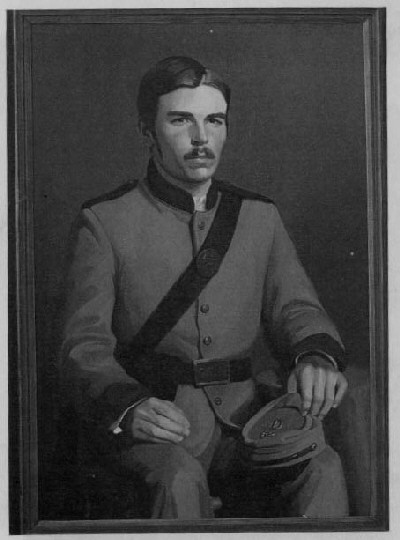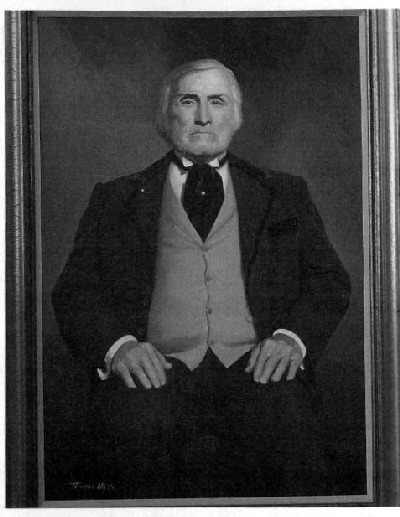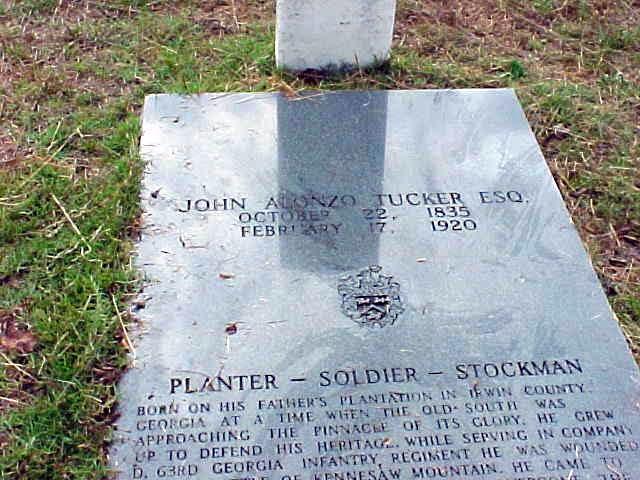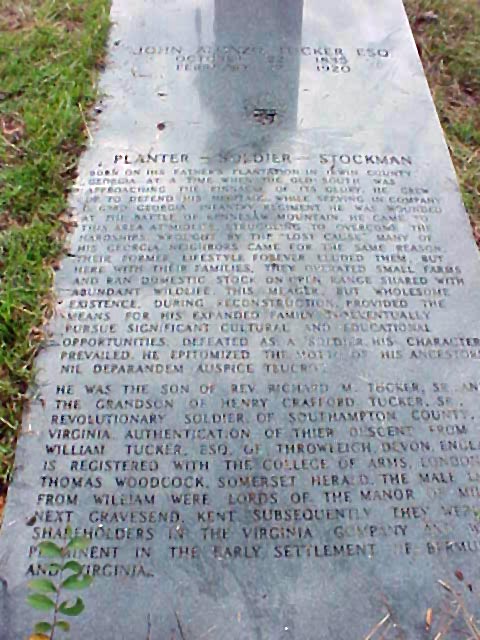

John Alonzo Tucker was born on his father's plantation in Irwin County, Georgia on 22 October 1835 to Richard Murphy Tucker (1801-1874) and Mary "Mollie" Paulk (1807-1878).

This property was later cut into Berrien County upon its formation. It is located near the community of Gladys, GA near the Irwin-Berrien County line. He was described as a tall strong man with blue eyes and fair complexion. He was a man of determination and purpose, but with a good sense of humor and willing to help his neighbors. He was described as an avid reader and active in community concerns.
The Tucker family was aware of the changing times, but felt the North was unduly influencing their ability to conduct business and to decide their lifestyle. Since the victors tend to dominate the writing of history. The North would have you believe that the South fought for the preservation of slavery and that the North fought a noble cause. When facts are studied regarding economic and other influences that the North inflicted on the South in the 1850's and beyond, it is easy for the educated person to see the less noble economic motives of the North and the hypocrisy regarding human rights. The Tucker family often expressed their believe that a war was inevitable because the Northern greed masked in the emotionalism of abolitionism.
John Tucker assisted his father in operation of the plantation until he enlisted in the Confederate Army at Savannah, 23 Sept 1863, and was assigned to Company D 63rd Georgia Volunteer Infantry by Capt. Harrision. At the time he joined the Army, he was married to Samantha Davis (1836-1866) and had two sons Elijah "Little Lige" (1858-1928), and Micajah (1860-1930). A third son John (1863-1886), was born 2 months later. John went to war reluctantly. He was quoted as saying "I have no desire to kill another man, not even a Yankee!"
The 63rd was originally commanded by George A. Gordon. The regiment was formed in Dec 1862 by the merging of several misc. units including: The Oglethorpe Artillery, Company D of Ramsey's 12th Georgia Artillery, 13th Infantry battalion (which served as a coastal defence unit) an other detached companies. They were to serve as battery and other defenses in the Savannah River systems for costal defense. On 10 July 1863 regiments of the 1st, 12th, 18th & 63rd Georgia (534 men) are ordered from District of Georgia (mostly from Savannah area) and join with the 21st South Carolina and Nelson's Battalion and became the garrison of Battery Wagner in defense of Charleston under the overall command of Colonel CH Olmstead.
On 2 August 1863, the 63rd Georgia, ranks reduced due to casualties and sickness are ordered to return to Savannah. Replacements are requested from troops who are more appropriate for artillery duty. (OR 1, 28 pg 73+) Casualty reports from Morris Island 10 July-7 Sept 1863 show the 63rd losses at Battery Wagner at 4 men killed , 2 officers wounded, 8 men wounded. (OR 1, 28 pg 406) John Tucker is initially assigned to the Department of South Carolina, Georgia and Florida to serve as one of the needed replacements.
The Department of South Carolina, Georgia & Florida was commanded by General P.G.T. Beauregard. From 13 Mar 1863 to 8 May 1863 in the District of Georgia the 63rd was classified as unattached. Brigader General Hugh W. Mercer is commander of the district, while Colonel George A. Gordon is in command of the regiment. They were also listed as the Phoenix Georgia. Volunteers. (OR 1, 14, pg 824) The regiment served on Thunderbolt and Rosedew Islands for the defensive effort of the Savannah area. In this assignment, the designation of infantry unit changed to heavy artillery batteries. They fought and successfully repelled Union attempts to invade and occupy Savannah by sea. On a Company Muster Roll for September and October of 1863 J.A. Tucker is listed as "present, having pay due from enlistment, enlisted since last muster, sick at post." On a November and December Company Muster Roll it is noted "Enlisted since muster in August, Pay due from enlistment, Detailed to Cook."
On 23 January 1864 the 63rd Georgia regiment is listed at 1,105 men (10 Companies) strong. (OR 1, 35 pg 542) J. Tucker on January and February Company Muster Roll is shown "paid by Capt. White on 31 December 1863, present, detailed to cook."
In the Spring of 1864 the 63rd Georgia was again designated as infantry and assigned to General Hugh W. Mercer's brigade. On 16 April 1864 Colonel Gordon and the 63rd was ordered by Robert E Lee to report by rail to Headquarters, Army of Northern Virginia, for assignment to Brigader General AR Wright's Brigade. (OR 1, 33) On 22 April 1864, Major. General Sam Jones writes to General Robert E Lee, stating that the 63rd may as well move ahead to the Army of Northern Virginia. They had been serving as heavy artillerist, and are being replaced by the 12th Georgia Battalion which is more suited to artillery. (OR 1, 35-2) On 26 April 1864 Colonel Gordon and the 63rd are urged by command to hurry to the ARMY OF NORTHERN VIRGINIA HQ. (OR 1, 35-2)
On 27 April 1864 Colonel Gordon and the 63rd orders are changed. The 64th Georgia. is ordered to ARMY OF NORTHERN VIRGINIA in place of the 63rd. (OR 1, 33) On 28 April 1864 Colonel Gordon and the 63rd was ordered by Lt. Gen JE Johnston to move by rail to Army of the Tennessee HQ in Dalton Georgia from Savannah. (OR 1 32 pt 3, pg 838) The change in orders, as requested by Corps Commanders indicate the confusion and desperation of the campaigns ahead. The western army was building forces in anticipation of the commencement of the campaign to defend Atlanta. On this campaign the regiment served with Mercer's Brigade included the 1st, 54th, and 63rd Georgia Infantry Regiments. John Tucker is found on a Receipt Roll for 2nd quarter", dated 27 April 1864.
63rd Georgia Infantry was consolidated into the new 1st Georgia Brigade (1st, 57th and 63rd Georgia infantry combined) under Lt. General Joseph E Johnston Command, Lt. Gen William J Hardee Corps, Major General John C Brown's Division, Brigader General James A Smith Brigade. The 1st Georgia was now commanded by Colonel Charles Olmstead 2 May 1864. They were with Johnston at the final surrender in North Carolina.
With Polk's corps detached to Alabama, Johnston had barely 45,000 troops and could only hope, through careful retreats, to induce Sherman to attack under circumstances most favorable to the defense. Brigade command subsequently passed to General C.H. Stevens and then to General H.R. Jackson.
John Tucker and the 63rd Georgia fought in the Battle of Resaca in May of 1864. Colonel George A. Gordon commanded the regiment in John Tucker's first infantry battle. On May 4 the tactical campaign began. Setting out on the same day as Grant's Wilderness campaign began in Virginia, McPherson left Lee & Gordon's Mill on Chickamuga Creek and headed south behind the screen of Rocky Face, planning to cross at Snake Creek Gap and seize the railroad at Resaca, 18 miles behind Johnston. On the same date, recalled from Alabama, Polk began his rush to bring a third Confederate Corps to meet Johnston at Resaca. Leaving Snake Creek Gap on May 9 McPherson was surprised to find Resaca fortified by the first arrivals from Polk and could not push on to the rail line. On the 9th Hood was leading one of his divisions and two of Hardee's, including Walker's, from Dalton to Resaca. When the next day brought no significant fighting at Resaca Hood returned to Dalton, posting Walker's and Cleburne's divisions at Tilton, halfway to Dalton, so they could move in either direction when Sherman's intentions became clear. Sherman's original intentions had already changed when McPherson failed to take Resaca. Tucker survived these battles around Resaca unharmed and participated in the numerous running fights and skirmishes to follow.
Between May 10 and 13 Thomas' huge army disengaged along Rocky Face and moved down the west side of the ridge to join McPherson near Resaca. Johnston, however, abandoning Dalton on the morning of the 13th, was there before Sherman, with all of Polk's third corps and in well constructed entrenchments to boot.
In day long fighting on May 14 Sherman made little headway along Johnston's four mile line extended between the Oostenaula and Conasauga Rivers. McPherson advanced with modest success against Polk near the Oostenaula, Hardee's four divisions held Thomas in check across the center, and, late in the day, Hood charged and drove Schofield back nearly a mile near the Conasauga. Overnight Johnston received reports of a Federal force crossing the Oostenaula south of Resaca at a point within easy march of the Western & Atlantic. Walker's division was detached immediately from the center of the line. At noon on May 15 Walker reported that he had found no Federal army in Johnston's rear. Johnston had no time to relax, however, when Walker's report changed at mid-afternoon. McPherson's army had been found at Lay's Ferry, further from the rail than had been feared, but east of the Oostenaula. Johnston's position at Resaca was doomed and the withdrawal was carried out overnight.
Johnston's forces were outnumbered 2 to 1 forcing a defensive posture to the Southern Army. Moral of the regiment was high. They were defending their home state from invasion. Sherman with his superior numbers was relentless in striking, flanking and trying to route these Southern troops. The Army of Tennessee continue to fall back closer and closer to Atlanta. The 63rd was to fight in the upcoming battles of Cassville, New Hope Church, Lost Mountain and Kennesaw Mountain.
On May 16 Johnston's army reached Calhoun where Walker's division rejoined them. Sherman prepared for Johnston to give battle there but the Confederates moved again that night, ten miles further south to Adairsville. There was heavy skirmishing at Adairsville near sundown on 17 May. The 1st Battalion was involved and sustained casualties there. By daybreak on the 18th, however, Johnston had his men moving again, now in two parts. Hardee moved south on the railroad to the Rome spur junction at Kingston; Polk and Hood left the rail and reached Cassville, due east of Kingston, by road.
While Hardee skirmished with Thomas along the rail giving the impression that his corps was guarding the retreat of the other two corps, Johnston readied Polk and Hood for a surprise strike at Schofield, approaching Cassville oblivious of the rebel presence there. On mid-morning on May 19, as Hood prepared to move, a blue column was reported at his right rear. The attack was canceled for what turned out to be only a lost Federal cavalry unit. Again Johnston was forced to take up a defensive position, this time southeast of Cassville along a wooded ridge, where Hardee's corps joined them late in the afternoon. As evening fell the contending armies lobbed artillery shells at one another over the tiny town between their lines.
Johnston and Hardee favored fighting at Cassville, north of the Etowah River, but Polk and Hood disagreed. Another night retreat was ordered. By the end of the day on 20 May Johnston's Army of Tennessee had assumed the strongest position yet in the campaign, the railroad gorge at Allatoona Pass below Cartersville.
After resting his troops for three days Sherman crossed the Etowah well to the west of Allatoona, between Rome and Stilesboro, on 23 May. Once again though Johnston moved first, up Pumpkinvine Creek toward Dallas. When the Federals had readied their advance two days later, on 25 May, the Confederates had already established a strong line from Dallas to New Hope Church, with Hardee at the former, Hood the latter, and Polk in the center. First to reach this latest line, Hooker threw 20,000 men against one division of Hood's corps at New Hope Church. The Federal attack failed with heavy losses and ended in a violent late afternoon thunderstorm. Two days later, attempting to turn Johnston's right near Pickett's Mill, the Federal attack fell upon Cleburne's division, detached from Hardee to the right, with much the same result, three Union casualties for every Confederate one.
As Sherman edged eastward, still aiming to turn Johnston's right or get back to the rail line, Johnston moved again on the night of 4 June. Along the new line Hardee's corps held the left on Lost Mountain and at Gilgal Church, Polk held the center from Pine Mountain to the railroad, and Hood anchored the right, east of the railroad to Brush Mountain. Two miles in their rear loomed Kennesaw Mountain. The 63rd was to soon fight a particularly distinguished battle at Kennesaw Mountain.
During the second week of June Sherman conformed and tightened his lines but declined further fight. Johnston tightened his own line, concentrating Hardee at Gilgal Church, bringing Hood back to the rail line, and leaving the mountains at either end to cavalry and sharpshooters. The 1st Battalion remained on Lost Mountain. On the morning of 14 June, Johnston, Hardee, and Polk rode to the top of Pine Mountain, a salient in the center of the line, to evaluate the safety of holding the exposed position there. In plain view of Federal artillerists below, the appearance of the three drew a quick volley. Hardee and Johnston scrambled for cover but Polk was killed on the spot. Before morning on 15 June Pine Mountain was abandoned and the Confederate line further tightened.
On 16 June Sherman at last decided to attack Johnston's army head on; Johnston, however, had already moved again and established a convex line centered atop Kennesaw Mountain. Polk's corps, now commanded by General W. W. Loring, occupied the heights with Hood on the railroad to the right and Hardee to the left blocking the road from Dallas to Atlanta. While Sherman pondered his next step Federal artillery kept up the bombardment of the twin peaks of Kennesaw and Schofield probed to the right, southwest of the mountain. Unable to turn either of Johnston's flanks without risking loss of his grip on the railroad, Sherman ordered a surprising frontal assault for the morning of June 27th.
Shermans push had forced the Confederates to take defensive positions on the heights of Big and Little Kennesaw. On the early morning of 27 June 1864, Sherman ordered General McPherson to attach the entrenchments. The temperature that day was recorded at over 100 degrees indicative of hell on earth and the savage fighting that would ensue.
At 8:00 am on the appointed morning 200 Union guns began an hour long "softening" of Johnston's entrenchments. Sherman committed only four divisions, sending two across the lower slope of Little Kennesaw and two more along the Burnt Hickory Road. Both were quickly halted and thrown back. The fiercest fighting was centered on Hardee's corps where its line turned, southwest of Little Kennesaw, a spot remembered as the "Dead Angle." Walker's division, posted between the base of the mountain and the Dead Angle, was engaged in the fighting, though effective artillery fire from batteries on Little Kennesaw withered the charge in their front and held their losses to a minimum.
The men of the 63rd Georgia were placed as skirmishers, 250 yards in front of the main confederate defense works. They were positioned to the left of Burnt Hickory Road at the base of the mountain, looking south from the Southern entrenchments. The Federal forces primary attack was at the 63rd Georgia to get to the main Confederate line behind them. Six Yankee regiments (30th Ohio, 47th Ohio, 37th Ohio 53rd Ohio, 54th Ohio and 83rd Indiana) composed the first assault force. The 63rd fired a volley that staggered the initial attack wave, but unknown to them, General French's skirmishers on their right had vacated their positions. This opened the right flank. The 63rd fought valiantly against overwhelming odds. After a few initial firings, there was no time to reload. Combat took the form of hand-to-hand, bayonet, and muskets used as clubs. The Georgians fought with everything they had, but the union forces continued to pour into their line. They were now completely surrounded and cut of from the main Southern line. Somehow the defenders broke through the Union Army noose and made it back to the main line. Many men were killed, wounded and captured. In this final push, John Tucker sustained a wound. A musketball or shell fragment imbedded into his upper back.
One of the more interesting reports of 27 June regarding the participation of the 63rd Georgia in this battle is from Lt. Colonel R. A. Fulton, commander of the 53rd Ohio to Captain A.C. Fisk, assistant adjutant-general, 2nd Brigade, United States Army. He reported finding rifle pits of the 63rd Georgia on the outer edge of the woods. The fighting was hand to hand combat, use of bayonets and rifle butts. The union officer captured 40 men and estimated killing and wounding another 40. (OR 1 38-pt 3) In this report, he relates the activities of his regiment as follows:
"At 8:00 am the signal was given and we moved forward over the works, charged through an open field, under a galling fire from the enemy's musketry and artillery, reached the edge of the woods and crossed the ravine. We were halted and reformed the line, the enemy keeping up a continuous fire of musketry and artillery from their works. In about 15 minutes the bugle sounded "Forward". In an instant the line moved forward with a yell through the woods and underbrush, over logs and ravines, and mounted the enemy's rifle pits, situated at the outer edge of the woods, occupied by the 63rd Georgia regiment. After a desperate hand-to-hand fight, in which the bayonet and butts of muskets were used, we succeeded in capturing their works. we captured about 40 prisoners, killing and wounding more than that number. The rebels fought with a desperation worthy of a better cause."
In a communique from Major General Walker to Major General French dated 27 June 1964:
"They (63rd Georgia) meet a line of battle which they gallantly fought with today, being clubbed and bayonetted in the pits, owing, they say, to the enemy having passed on their right flank, where your skirmishers were suppose to be."
By midday on 27 June the battle of Kennesaw Mountain was over. Union losses stood at 2041, Confederate at only 552. The two and one half hour battle cost Sherman 2000 men and won him nothing in strategic advantage. After two days in stalemate a truce for burial of the dead was agreed to on 30 June. The campaign's second month was at an end. While Union losses for the two-month campaign now exceeded the Confederate, the rate at which the forces were being depleted was far in the Federal favor. One in four Confederate soldiers marching south from Dalton had been killed, wounded, or captured; of the Federals, one in seven. The 63rd on 30 June 1864 is listed with the Army of Tennessee, Hardee's Corps, Walkers Division, Mercers Brigade (includes 1st, 54th, 57th, & 63rd Georgia -Colonel Gordon) (OR 1, 38-Pt 3, pg 648). A few days later the works at Kennesaw were abandoned.
John Tucker was removed with other wounded Confederate troops and sent to hospitals in the Atlanta area. He ultimately found himself at a Confederate hospital at Emory College in Oxford, Georgia The Yankee metal was so deeply embedded in his back, the surgeons dared not remove it. In fact it was never removed. He carried that bullet/fragment in his body for 56 more years until his death. Also wounded in at Kennesaw was brigade commander Mercer's son who was in hospital with Tucker. John pointed out that his grandfather Henry Crofford Tucker fought alongside General Hugh Mercer in the American Revolution and now the Tuckers and Mercers were again fighting side by side in the War for Southern Independence.
Little is known about John Tucker's activities as a Confederate after the fall of Atlanta. We do know that John Tucker was paroled in Thomasville, Georgia on 25 May 1865. In an entry for J. Tucker, Private, 63rd Ga Inf., he "appears on a Roll of Prisoners of War beloning to the Confederate Army, surrendered by Major General Sam Jones, commanding Confederate Forces in Florida, to Brigader General E.M. McCook, U.S.V., commanding U.S. Forces at Tallahassee, Florida, in compliance with the terms of a Military Convention made on 26 April 1865 at Bennett's House, near Durham's Station, North Carolina, between General J.E. Johnston of the Confederate Armies and Major General W.T. Sherman, U.S.A., and approved by Lieutenant General U.S. Grant, U.S.A." parolled at Thomasville, Ga 24 May 1865. Another entry is found for J. Tucker, private, 63rd Ga Inf "Appears in a list of Prisoners of war surrendered to Brigader General E. M. McCook by Major General Sam Jones, C.S.A. at Tallahassee, Florida 10 May 1865. Here it states " Where paroled-Thomasville, GA. When paroled-25 May 1865. This shows we have two dates (24th and 25th) as parole dates.
Wife Samantha (Davis) Tucker died in childbirth or shortly thereafter in May 1866. The fourth child, Ann "Joamie" Tucker (1866-1932) survived and married Lewis Griffin (1857-1923). (Ann Tucker and Lewis Griffin were my great-grandparents.) John Tucker second married (1868) Martha Corbitt of Clinch County, Georgia, and they had six more children Joseph (1869-1938), Loranzo (1872-?), Eliza (1873-1954), Catherine (1876-?), Frederick (1878-1954), and Missouri (1881-?). From 1870-1880 they resided and farmed in Clinch Co. In 1880 they returned to Berrien County. Later they moved to Kinard in Calhoun County, Florida. John farmed and raised livestock (he maintained a large herd of Cattle) and also served at the postmaster of this community. He third married Sarah Carver, late in life, after Martha died. John Alonzo Tucker died on 17 Feb 1920 and is buried at Cypress Creek Church Cemetery about one mile north of Kinard, Florida.


The above was compiled by John Griffin If you have additions, corrections, or comments, please contact him.